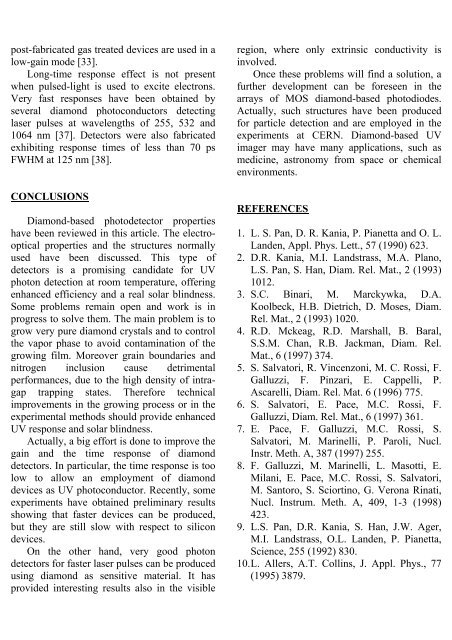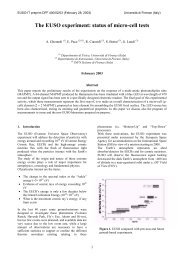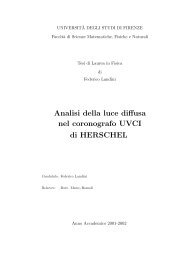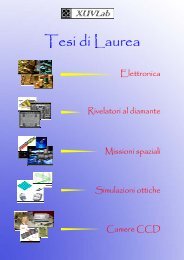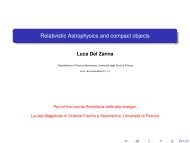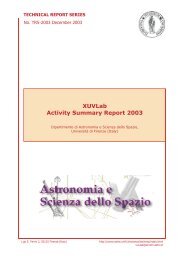Diamond-based UV and soft X-ray photodetectors E. Pace Dip. di ...
Diamond-based UV and soft X-ray photodetectors E. Pace Dip. di ...
Diamond-based UV and soft X-ray photodetectors E. Pace Dip. di ...
You also want an ePaper? Increase the reach of your titles
YUMPU automatically turns print PDFs into web optimized ePapers that Google loves.
post-fabricated gas treated devices are used in alow-gain mode [33].Long-time response effect is not presentwhen pulsed-light is used to excite electrons.Very fast responses have been obtained byseveral <strong>di</strong>amond photoconductors detectinglaser pulses at wavelengths of 255, 532 <strong>and</strong>1064 nm [37]. Detectors were also fabricatedexhibiting response times of less than 70 psFWHM at 125 nm [38].CONCLUSIONS<strong>Diamond</strong>-<strong>based</strong> photodetector propertieshave been reviewed in this article. The electroopticalproperties <strong>and</strong> the structures normallyused have been <strong>di</strong>scussed. This type ofdetectors is a promising c<strong>and</strong>idate for <strong>UV</strong>photon detection at room temperature, offeringenhanced efficiency <strong>and</strong> a real solar blindness.Some problems remain open <strong>and</strong> work is inprogress to solve them. The main problem is togrow very pure <strong>di</strong>amond crystals <strong>and</strong> to controlthe vapor phase to avoid contamination of thegrowing film. Moreover grain boundaries <strong>and</strong>nitrogen inclusion cause detrimentalperformances, due to the high density of intragaptrapping states. Therefore technicalimprovements in the growing process or in theexperimental methods should provide enhanced<strong>UV</strong> response <strong>and</strong> solar blindness.Actually, a big effort is done to improve thegain <strong>and</strong> the time response of <strong>di</strong>amonddetectors. In particular, the time response is toolow to allow an employment of <strong>di</strong>amonddevices as <strong>UV</strong> photoconductor. Recently, someexperiments have obtained preliminary resultsshowing that faster devices can be produced,but they are still slow with respect to silicondevices.On the other h<strong>and</strong>, very good photondetectors for faster laser pulses can be producedusing <strong>di</strong>amond as sensitive material. It hasprovided interesting results also in the visibleregion, where only extrinsic conductivity isinvolved.Once these problems will find a solution, afurther development can be foreseen in thear<strong>ray</strong>s of MOS <strong>di</strong>amond-<strong>based</strong> photo<strong>di</strong>odes.Actually, such structures have been producedfor particle detection <strong>and</strong> are employed in theexperiments at CERN. <strong>Diamond</strong>-<strong>based</strong> <strong>UV</strong>imager may have many applications, such asme<strong>di</strong>cine, astronomy from space or chemicalenvironments.REFERENCES1. L. S. Pan, D. R. Kania, P. Pianetta <strong>and</strong> O. L.L<strong>and</strong>en, Appl. Phys. Lett., 57 (1990) 623.2. D.R. Kania, M.I. L<strong>and</strong>strass, M.A. Plano,L.S. Pan, S. Han, Diam. Rel. Mat., 2 (1993)1012.3. S.C. Binari, M. Marckywka, D.A.Koolbeck, H.B. Dietrich, D. Moses, Diam.Rel. Mat., 2 (1993) 1020.4. R.D. Mckeag, R.D. Marshall, B. Baral,S.S.M. Chan, R.B. Jackman, Diam. Rel.Mat., 6 (1997) 374.5. S. Salvatori, R. Vincenzoni, M. C. Rossi, F.Galluzzi, F. Pinzari, E. Cappelli, P.Ascarelli, Diam. Rel. Mat. 6 (1996) 775.6. S. Salvatori, E. <strong>Pace</strong>, M.C. Rossi, F.Galluzzi, Diam. Rel. Mat., 6 (1997) 361.7. E. <strong>Pace</strong>, F. Galluzzi, M.C. Rossi, S.Salvatori, M. Marinelli, P. Paroli, Nucl.Instr. Meth. A, 387 (1997) 255.8. F. Galluzzi, M. Marinelli, L. Masotti, E.Milani, E. <strong>Pace</strong>, M.C. Rossi, S. Salvatori,M. Santoro, S. Sciortino, G. Verona Rinati,Nucl. Instrum. Meth. A, 409, 1-3 (1998)423.9. L.S. Pan, D.R. Kania, S. Han, J.W. Ager,M.I. L<strong>and</strong>strass, O.L. L<strong>and</strong>en, P. Pianetta,Science, 255 (1992) 830.10. L. Allers, A.T. Collins, J. Appl. Phys., 77(1995) 3879.


